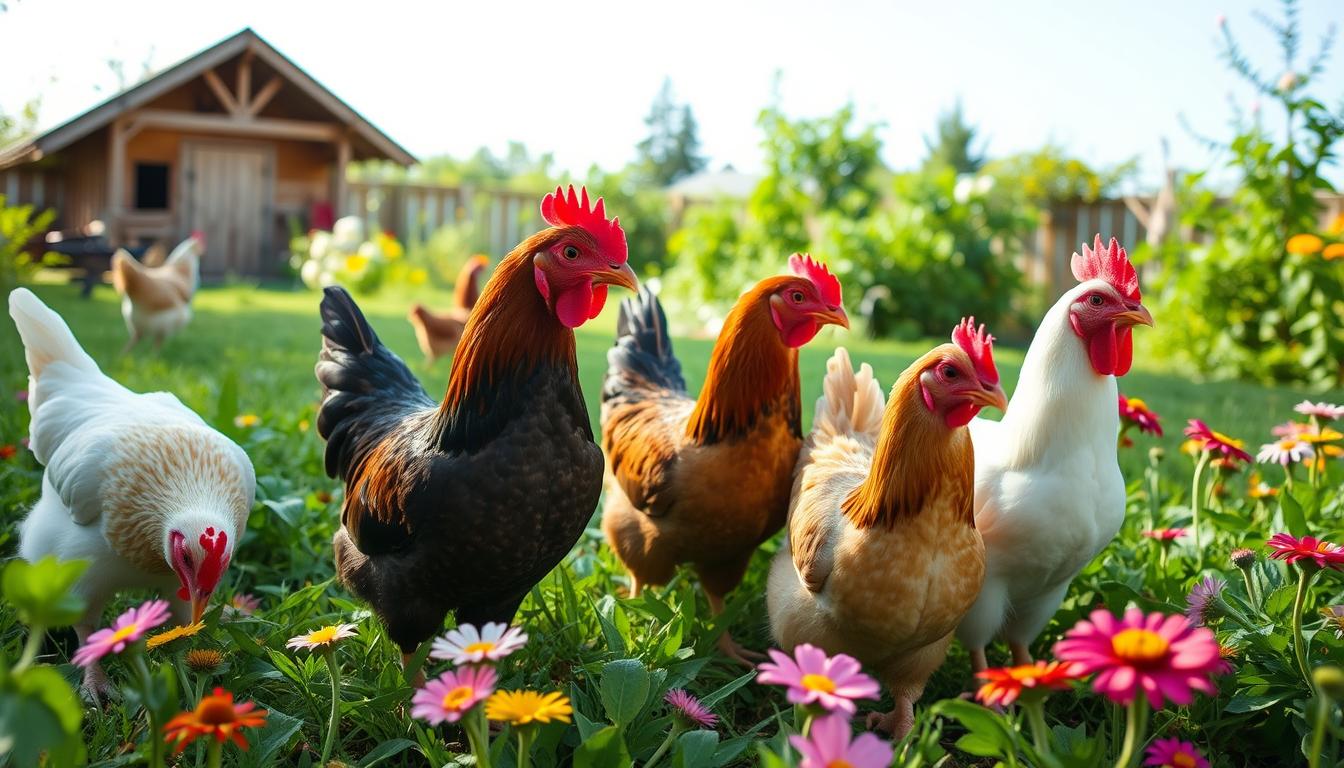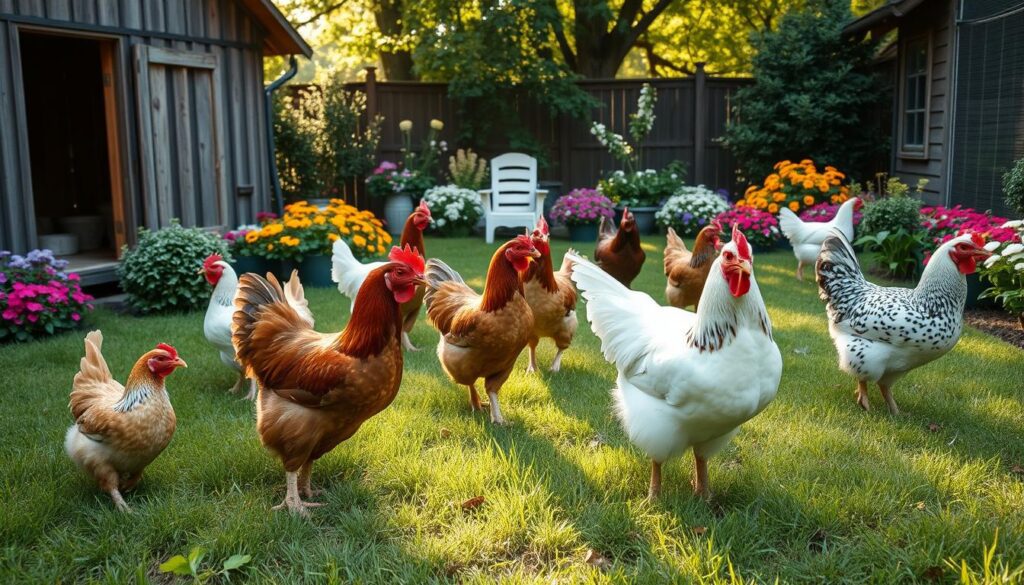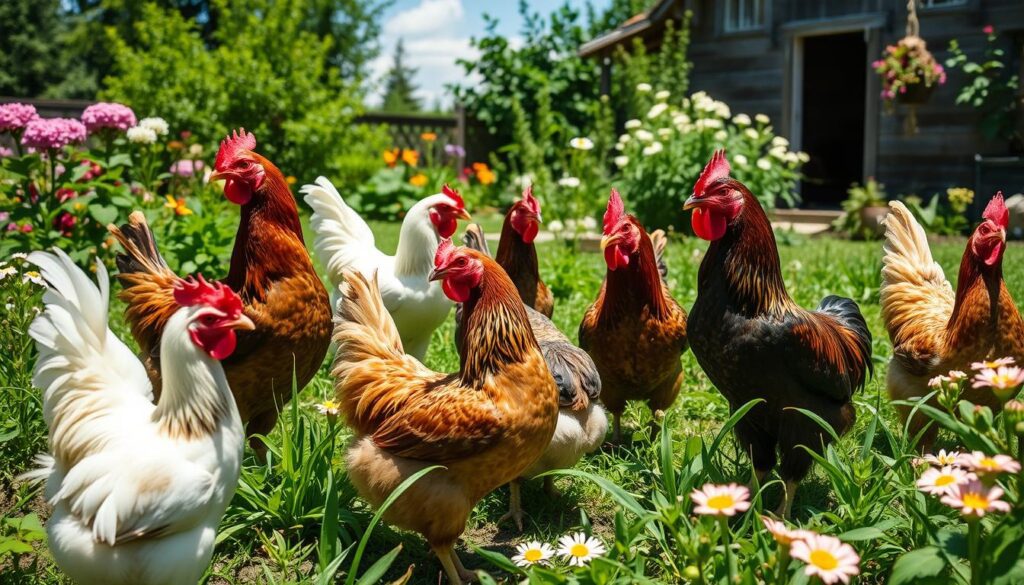The Top Egg-Laying Chickens for Your Backyard

Choosing the right breed is key when raising backyard chickens. Some breeds, like White Leghorn chickens, lay over 300 eggs a year1. They are among the best for egg production. Australorp chickens also lay more than 300 eggs annually1, making them top choices for eggs.
With many breeds to pick from, it’s hard to know which will lay the most eggs. ISA Brown chickens lay up to 300 eggs a year1. They are a great option for your backyard.
Whether you’re new to chicken keeping or experienced, knowing the best breeds is crucial. Leghorns can lay between 280-320 eggs a year2. Australorps average about 250-300 eggs annually2. Choose breeds known for high egg production, like Rhode Island Reds, which lay 200-300 eggs a year1.
Key Takeaways
- Choose breeds like White Leghorn chickens that are known for their high egg production, making them one of the best laying chickens.
- Consider the characteristics of the best laying chickens, such as their egg production expectations and care requirements, to make informed decisions about which breeds to include in your flock.
- Understand the factors that affect laying performance, such as nutrition and health, to maximize egg production from your top egg-laying hens.
- Look for productive chicken breeds like ISA Brown chickens that are known for laying up to 300 eggs per year1.
- Learn about the different breeds, such as Australorp chickens, and their unique characteristics to determine which ones are right for your backyard.
- Consider the average egg production expectations of different breeds, such as Leghorns, which can produce between 280-320 eggs per year2.
Understanding Best Laying Chickens: A Comprehensive Guide
Choosing the right chicken breed for eggs is key. Breed, nutrition, and health all play a big role. High-yield egg layers, like the top laying breeds, can lay up to 300 eggs a year3. Breeds like Rhode Island Reds and Leghorns are known for their egg-laying prowess.
Some top chicken breeds for eggs are:
- Rhode Island Reds, which can lay up to 270 eggs per year3
- Leghorns, which can lay around 280 eggs per year3
- Australorps, which can lay up to 300 eggs per year3
Nutrition and health also matter for egg production. Chickens need a diet rich in protein and calcium for quality eggs. Keeping them in a clean, healthy environment also helps. This way, you can have a flock that lays plenty of eggs.
Each breed has its own traits that can affect egg-laying. Some breeds might get broody, which can lower egg production. By picking the right breed for your needs, you can have a productive and healthy flock. With the right care, you’ll get a steady supply of fresh eggs.
Essential Characteristics of Productive Egg Layers
Choosing the right egg-laying chickens for your backyard is important. Productive chicken breeds can lay up to 300 eggs a year4. Look for breeds that are friendly, good at finding food, and can handle cold weather. For example, the Australorp is calm and gentle, perfect for backyard flocks5.
Highly productive hens can handle different climates well. Breeds like the Rhode Island Reds are great for small flocks and various environments6. It’s also key to provide a good home for your chickens. This means clean, well-ventilated coops and enough space for each chicken. You can find more tips on raising productive chicken breeds and how to get the most eggs from them.
Some important traits of egg layers include:
- Docility and calm nature
- Foraging ability and adaptability to different environments
- Cold hardiness and ability to thrive in various climates
By picking breeds that fit your backyard, you can get lots of fresh eggs4.
Leghorn: The Classic High-Production Layer
The Leghorn breed is a favorite among backyard farmers. They are known for laying a lot of eggs. Leghorns can lay over 300 eggs a year, with some strains laying 6 eggs a week7.
Leghorns are also good at turning feed into eggs, which saves money. They need a diet with 16-18% protein to stay healthy and keep laying eggs8. For more info on raising Leghorns, check out Grubbly Farms.
Here are some key characteristics of Leghorns:
- High egg production, with some breeds laying over 300 eggs per year9
- Efficient feed-to-egg conversion ratio7
- Relatively low maintenance, requiring a balanced diet and adequate space8
White Leghorn Specifics
White Leghorns are famous for their egg-laying skills. They are small, friendly, and easy-going, weighing 4-5 pounds9.
Expected Egg Output
Leghorns lay around 280-320 large white eggs a year. Some breeds lay even more8. They are consistent, making them great for backyard farmers.
Rhode Island Reds: American Heritage Layers
Rhode Island Reds are a top pick for backyard farmers looking for egg-laying chickens. They are known for their dark feathers and high egg production10. Their friendly nature makes them a great addition to any flock.
These chickens lay about 200-300 eggs a year10. They start laying eggs at 4 to 5 months old11. This makes them a favorite among backyard chicken keepers.
Rhode Island Reds have a large body and yellow skin11. They are big in personality, perfect for families. As heritage breeds, they love foraging and are great in free-range environments11.
They are easy to care for, tolerating extreme temperatures11. With proper care, they can live 5-8 years or more. This makes them a wise choice for backyard farmers.
Rhode Island Reds are perfect for those wanting a productive and friendly chicken. They lay lots of eggs and are easy to care for. They are ideal for backyard farmers looking to produce eggs regularly.
| Breed | Egg Production | Personality |
|---|---|---|
| Rhode Island Reds | 200-300 eggs per year | Friendly and outgoing |
| Leghorns | 280-300 eggs per year | Active and noisy |
| Australorps | 250 eggs per year | Docile and laid-back |
Australorp: The Record-Breaking Layer
Australorps are famous for laying lots of eggs, making them a top pick for backyard chicken keepers12. They can lay up to 250 large brown eggs each year12. Some Australorps even break records, laying over 300 eggs annually12.
These chickens are perfect for those wanting to get the most eggs. They do well in warm weather and can handle cold too13. Their shiny black feathers with a green sheen make them a beautiful sight12.
Australorps are big birds. Males grow to 8½-10lbs, and females to 6½-9lbs13. They also come in bantam size, with roosters at 2-4lbs and hens at 1.7-4lbs13. Their long history and egg-laying skills make them a great choice for backyard flocks.
Managing Your Laying Flock for Maximum Production

To get the most eggs from your best laying chickens, managing your flock well is key. This means giving them a balanced diet, checking their health often, and keeping their coop clean and comfy. The third web source says feeding right, health checks, and a clean coop are vital for a laying flock.
A well-cared-for flock of top egg-laying hens can lay a lot of eggs. For instance, commercial White Leghorn-type hybrids can lay 200 to 260 eggs a year14. Purebred poultry, on the other hand, lay between 100 and 180 eggs a year14. To get the best egg production, it’s important to give your hens the right environment and care.
Some important things to think about when managing your laying flock include:
- Give each hen at least 1.5 square feet in the flock14
- Feed them an 18-20 percent protein starter for the first 6-8 weeks14
- Make sure they have enough water and space at the feeder14
By following these tips, you can help your best laying chickens lay more eggs and stay healthy. Also, remember that egg production goes down by 35% after a hen has been laying eggs for a year15.
With the right management and care, your flock of top egg-laying hens will do great. They’ll give you a steady supply of fresh eggs.
| Breed | Egg Production per Year |
|---|---|
| Commercial White Leghorn-type hybrids | 200-260 eggs |
| Purebred poultry | 100-180 eggs |
Plymouth Rocks: Dual-Purpose Excellence
Plymouth Rock chickens are a favorite for backyard flocks. They lay around 200 large, brown eggs per year16. They are also hardy and can handle different climates well.
These chickens are known for being friendly and having a moderate noise level16. They are good at avoiding predators. For those seeking top laying breeds, Plymouth Rocks are a great pick. Their hens lay light brown eggs that are medium to large in size17.
It’s important to know what Plymouth Rocks need, like their diet and housing. You can learn more about pet care and nutrition to keep your flock healthy and happy.
Barred Rock Characteristics
The Barred Rock is a popular variety of Plymouth Rock. It’s known for its barred feathers. They are friendly and make great additions to backyard flocks17.
Essential Housing Requirements for Laying Hens
Raising productive chicken breeds means giving them a comfy and safe place. They need a big coop with good air, nesting boxes, and perches. The third web source says a big coop, good air, and nesting boxes are key for happy hens.
To keep your highly productive hens happy and healthy, consider these must-haves:
- Ample space: Give them enough room to move around.
- Ventilation: Make sure there’s good air flow to avoid ammonia and moisture.
- Nesting boxes: Have one for every 3-4 hens to help them relax and lay eggs.
By giving them a comfy and safe spot, your hens will lay more eggs and stay healthy. Always do your research to know what your productive chicken breeds need for the best care18.
Feeding Strategies for Optimal Egg Production

Feeding your best laying chickens a balanced diet is key for egg production. You need to give them a mix of basic nutrients, supplements, and adjust their diet with the seasons. A chicken’s daily food intake changes based on what they eat, with energy content playing a big role19. They also eat more in cold weather to keep warm19.
Experts suggest a high-quality layer feed with 18% protein for hens20. It’s also important to ensure they have enough light, the right temperature, good air, and enough space for egg production20. Here’s a table of what laying hens need nutritionally:
| Nutrient | Requirement |
|---|---|
| Protein | 14-16% |
| Calcium | 2.5-3.5% |
| Energy | 2800-3000 kcal/kg |
By using these feeding strategies, you can help your top egg-laying hens lay more eggs and stay healthy1920.
Common Health Issues in Laying Breeds
When raising best chicken breeds for eggs, knowing common health issues is key. These can include diseases, parasites, and nutritional problems21. For example, egg-laying issues might stem from vitamin deficiencies, parasites, infections, or stress22. Keeping a balanced diet and a clean, safe space for your hens is crucial.
Health problems like cuts and peck marks can come from stress, crowding, or aggressive birds22. Foot injuries, like bumblefoot, can make a chicken not want to move or cause abscesses22. Keeping the coop clean and providing a nutritious diet is vital for your top laying breeds.
Parasitic diseases, like mites, lice, and worms, can hit laying breeds hard23. These can lead to feather loss, skin issues, tiredness, and loss of appetite. To avoid these, ensure good ventilation, cleanliness, and dry bedding in the coop23. Knowing these issues and how to prevent them can keep your hens healthy and egg-laying well.
For more on keeping your backyard chickens healthy, check out pet care resources. They highlight the importance of proper care and nutrition for your best chicken breeds for eggs. By following these tips and staying alert to common health issues, your hens will thrive and lay plenty of eggs.
Seasonal Considerations for Egg Production
Keeping backyard chickens means watching how seasons change. Breeds like Leghorns and Rhode Island Reds lay fewer eggs when it gets darker24. To help, add artificial light to keep their day long enough, at least 14 hours24.
Chickens need 12-17 hours of daylight to lay eggs25. Some, like Red Star and Golden Comet, keep laying all year25. But others, like Barred Plymouth Rock and Buff Orpington, do better in cold weather25. Ducks, on the other hand, lay eggs all winter without extra light25.
Here are some tips for winter care:
- Provide supplemental lighting to maintain a day length of at least 14 hours24
- Limit supplementation with scratch or table scraps to no more than 15-20% of a chicken’s total daily consumption24
- Ensure access to fresh, clean water and a balanced diet that includes calcium for strong eggshells25
By understanding these seasonal changes and taking action, you can keep your chickens healthy and laying eggs all year2425.
| Breed | Winter Laying Ability |
|---|---|
| Leghorn | May experience a reduction in egg production |
| Rhode Island Red | May experience a reduction in egg production |
| Red Star | Lays well year-round |
| Golden Comet | Lays well year-round |
Conclusion: Choosing Your Perfect Laying Breed
Choosing the right chicken breed is key for a happy backyard flock. Knowing the traits, care needs, and egg-laying of different breeds helps you pick the best. Simply Pets has a wide range of top chicken breeds for egg-laying.
Looking for a Leghorn that lays up to 280-320 eggs a year? Or maybe a Rhode Island Red that lays about 250 large brown eggs a year? There’s a breed that fits your backyard flock needs26. Hybrid breeds might lay a lot early on, while purebreds like Australorps and Orpingtons keep laying well into old age.
Think about egg size, color, and how they change with the seasons. Also, consider the breed’s personality and how it handles cold. With Simply Pets’ help, you can pick the best breed for your flock and enjoy fresh eggs all year27.
FAQ
What factors should I consider when choosing the best egg-laying chickens for my backyard?
What are some of the top egg-laying chicken breeds?
How can I manage my laying flock to maximize egg production?
What seasonal considerations should I keep in mind for egg production?
What are some common health issues that can affect laying chickens?
Source Links
- https://www.kalmbachfeeds.com/blogs/chickens/egg-laying-chicken-breeds-10-of-the-best-egg-laying-hens?srsltid=AfmBOopR-VygiBWlcWJ7JnMn8EZUfEHgTpL1G2bHE2iCKX43AFH382-g – Egg Laying Chicken Breeds: 10 of the Best Egg Laying Hens
- https://www.backyardchickencoops.com.au/blogs/learning-centre/the-top-8-best-laying-hens-for-backyard-chickens – The Top 8 Best Laying Hens For Backyard Chickens
- https://www.somerzby.com.au/blog/egg-laying-chickens/?srsltid=AfmBOooUytD3tXrl1RA5-oesOSzVPAptjl82R9H0dUY6Dr0m5vVemOYi – Ultimate Guide to Egg Laying Chickens-Best Breeds & Colours
- https://grow.ifa.coop/chickens/best-egg-laying-chickens – The Best Egg Laying Chickens: A Guide to Egg Production | IFA’s Blog
- https://extension.umn.edu/small-scale-poultry/raising-chickens-eggs – Raising chickens for eggs
- https://www.kalmbachfeeds.com/blogs/chickens/egg-laying-chicken-breeds-10-of-the-best-egg-laying-hens?srsltid=AfmBOooL1kpTpph6OSyWJo-Fs5Bkc8wIV2bzXnsrlt-EeVkIasnCKF3k – Egg Laying Chicken Breeds: 10 of the Best Egg Laying Hens
- https://grubblyfarms.com/blogs/the-flyer/the-leghorn-chicken-deep-dive?srsltid=AfmBOoqb0ubWXiG-8dvks_bywFt0V9Bt0zHKyyYKwnD4nxGdH31cn6Jg – The Leghorn Chicken Deep Dive
- https://www.coopsandcages.com.au/blog/leghorn-breed/?srsltid=AfmBOooXg5FEN3IKVfxyUMwTAY-b2WGSOaigdm6_vp4fqhlKFWNWKp93 – Leghorn Breed: The Egg-Laying Superstars You Need
- https://www.roobeez.com/blog/leghorn-chickens – Leghorn Chicken Guide: Everything You Need to Know About Leghorn Chickens — Roobeez
- https://grubblyfarms.com/blogs/the-flyer/rhode-island-red-chicken-deep-dive-a-guide-for-chicken-owners?srsltid=AfmBOoqOhmg-j0cAJD3zplbhCAjfqhfpJxQqt6bFV2_CEnRL2WymDURt – A Guide for Chicken Owners
- https://www.somerzby.com.au/blog/rhode-island-red-chickens/?srsltid=AfmBOooFOEemm5FxUOnBF9Q_7GSiUtChsK3oIP0dAk3hpw7XtUA92xEr – Rhode Island Red Chicken Breed Information | Somerzby
- https://www.coopsandcages.com.au/blog/australorp-chickens/?srsltid=AfmBOoqiWA7RWV__oMdoZ7DqWT4Z51ECrjzptj7NoLIBLVMfU2x3uUpe – Australorp Chickens: The Friendly, Egg-Laying Superstars
- https://chickenexperts.com/blogs/chickens/australorps-awesome-addition-or-awful-idea – Australorps – Awesome Addition or Awful Idea? 🤔
- https://extension.psu.edu/management-requirements-for-laying-flocks – Management Requirements for Laying Flocks
- https://extension.colostate.edu/topic-areas/agriculture/raising-poultry-the-organic-way-management-and-production-2-508/ – Raising Poultry the Organic Way – Management and Production – 2.508 – Extension
- https://www.thefeatherbrain.com/blog/plymouth-rock-chickens – Plymouth Rock chickens: The backyard chicken all-stars — The Featherbrain
- https://grubblyfarms.com/blogs/the-flyer/plymouth-rock-chicken-deep-dive?srsltid=AfmBOopQlknfXtnJpIqZUo7Oxf76IcKrRyaMgZdma5qOwO0cXomxLuqI – Plymouth Rock Chicken Deep Dive
- https://www.theprairiehomestead.com/2020/03/raising-laying-hens.html – Beginner’s Guide to Raising Laying Hens • The Prairie Homestead
- https://poultry.extension.org/articles/feeds-and-feeding-of-poultry/feeding-chickens-for-egg-production/ – FEEDING CHICKENS FOR EGG PRODUCTION IN SMALL AND BACKYARD FLOCKS
- https://www.freedomrangerhatchery.com/blog/optimizing-egg-laying-production/ – Optimizing Egg Laying Production | Freedom Ranger Hatchery Blog
- https://www.poultryhub.org/all-about-poultry/backyard-poultry/common-problems-and-treatment-methods-for-backyard-chickens – Common problems and treatment methods for backyard chickens – Poultry Hub Australia
- https://www.almanac.com/common-chicken-health-problems – Common Chicken Health Problems
- https://opensanctuary.org/common-chicken-health-issues/ – Potential Chicken Health Challenges – The Open Sanctuary Project
- https://smallfarms.oregonstate.edu/seasonal-changes-affect-poultry – Seasonal Changes Affect Poultry
- https://www.fresheggsdaily.blog/2021/09/how-to-keep-your-chickens-laying-eggs.html – How to Keep Your Chickens Laying Eggs Through the Winter
- https://grubblyfarms.com/blogs/the-flyer/choosing-the-right-chicken-breed-for-your-backyard?srsltid=AfmBOoqgAQs3MUHFq8ODoJyhClck5lprIpwL_dGVCvJUuG7IU_V_hV5j – Choosing the Right Chicken Breed for Your Backyard
- https://www.artfulhomemaking.com/best-chickens-to-lay-eggs/ – What are the Best Chickens to Lay Eggs?



